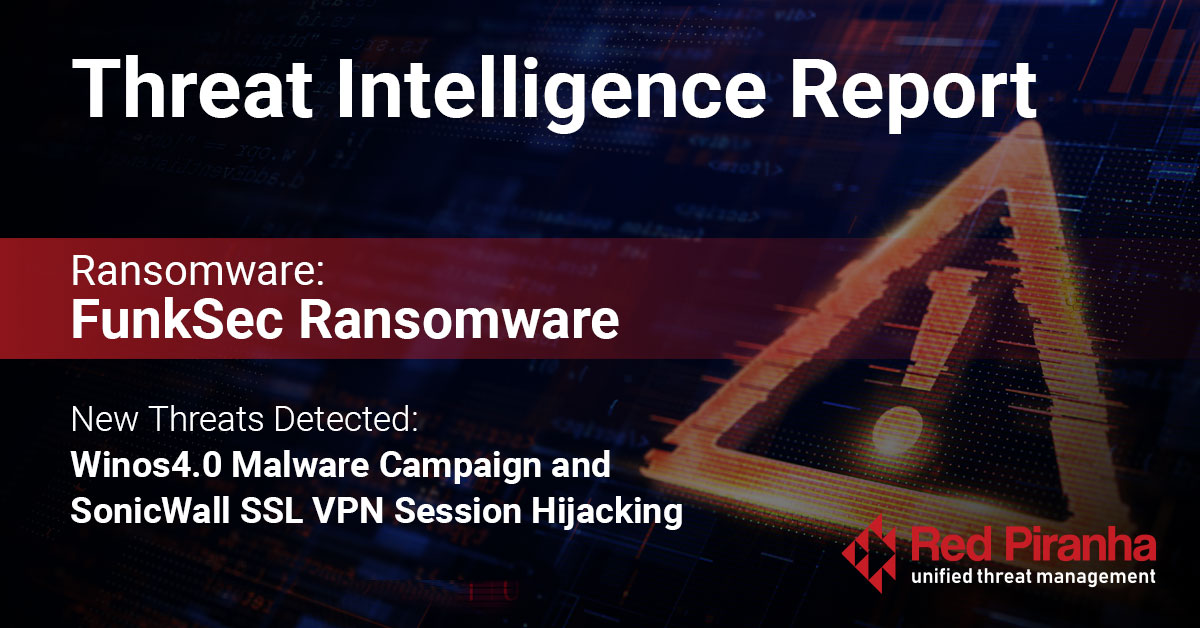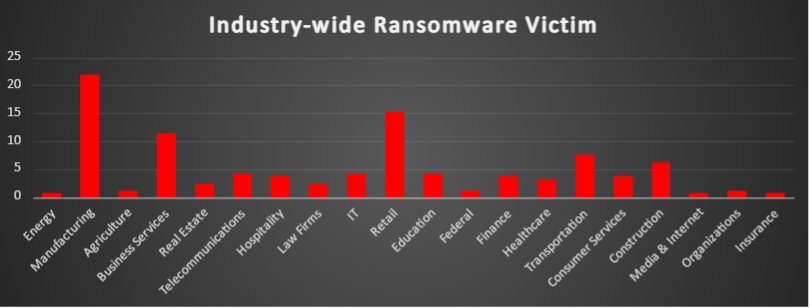
| New Threat Detection Added | 2 - Winos4.0 Malware Campaign and SonicWall SSL VPN Session Hijacking (CVE-2024-53704) |
| New Threat Protections | 144 |
Weekly Detected Threats
The following threats were added to Crystal Eye this week:
|
Threat name:
|
Winos4.0 Malware Campaign | ||||||||||||||||||
|
Winos4.0 is an advanced malicious framework, evolved from Gh0strat, featuring modular components for comprehensive functionality and stable architecture. It has been deployed in various attack campaigns, including Silver Fox. Researchers have identified multiple samples of Winos4.0 concealed within gaming-related applications, such as installation tools, speed boosters, and optimisation utilities. Analysis of the decoded DLL file indicates potential targeting of the education sector, as evidenced by its file description, “校园政务” (Campus Administration).
|
|||||||||||||||||||
|
Threat Protected:
|
05 | ||||||||||||||||||
|
Rule Set Type:
|
|
||||||||||||||||||
|
Class Type:
|
Trojan activity | ||||||||||||||||||
|
Kill Chain:
|
|
||||||||||||||||||
|
Threat name:
|
SonicWall SSL VPN Session Hijacking (CVE-2024-53704) | ||||||||||||||||||
|
CVE-2024-53704 is a critical authentication bypass vulnerability affecting the SSL VPN component of unpatched SonicWall firewalls. This flaw allows remote, unauthenticated attackers to hijack active SSL VPN sessions, granting unauthorised access to internal networks. Exploiting this vulnerability enables attackers to:
The vulnerability affects SonicOS versions 7.1.x (7.1.1-7058 and earlier), 7.1.2-7019, and 8.0.0-8035. SonicWall released patches addressing this issue on January 7, 2025. Organisations are strongly advised to apply these updates promptly to mitigate potential exploitation.
|
|||||||||||||||||||
|
Threat Protected:
|
02 | ||||||||||||||||||
|
Rule Set Type:
|
|
||||||||||||||||||
|
Class Type:
|
Attempted-admin | ||||||||||||||||||
|
Kill Chain:
|
|
||||||||||||||||||
Known Exploited Vulnerabilities (Week 2 - February 2025)
For more information, please visit the Red Piranha Forum:
https://forum.redpiranha.net/t/known-exploited-vulnerabilities-catalog-2nd-week-of-february-2025/546
|
Vulnerability
|
CVSS
|
Description | |
|
CVE-2024-40891
|
8.8 (High)
|
Zyxel DSL CPE OS Command Injection Vulnerability
|
|
|
CVE-2024-40890
|
8.8 (High)
|
Zyxel DSL CPE OS Command Injection Vulnerability
|
|
|
CVE-2025-21418
|
7.8 (High)
|
Microsoft Windows Ancillary Function Driver for WinSock Heap-Based Buffer Overflow Vulnerability
|
|
|
CVE-2025-21391
|
7.1 (High)
|
Microsoft Windows Storage Link Following Vulnerability
|
|
|
CVE-2025-24200
|
6.1 (Medium)
|
Apple iOS and iPadOS Incorrect Authorisation Vulnerability
|
|
|
CVE-2024-41710
|
Ongoing Analysis
|
Mitel SIP Phones Argument Injection Vulnerability
|
|
|
CVE-2024-57727
|
7.5 (High)
|
SimpleHelp Path Traversal Vulnerability
|
Updated Malware Signatures (Week 2 - February 2025)
|
Threat
|
Description
|
|
|
Lumma Stealer
|
A type of malware classified as an information stealer. Its primary purpose is to steal sensitive information from infected systems, including but not limited to credentials, financial information, browser data, and potentially other personal or confidential information.
|
| Ransomware Report | |
|
The Red Piranha Team conducts ongoing surveillance of the dark web and other channels to identify global organisations impacted by ransomware attacks. In the past week, our monitoring revealed multiple ransomware incidents across diverse threat groups, underscoring the persistent and widespread nature of these cyber risks. Presented below is a detailed breakdown of ransomware group activities during this period. |
|
| Name of Ransomware Group | Overall %age of total attack coverage |
|
Hunters
|
0.77%
|
|
Fsociety
|
1.15%
|
|
0.77%
|
|
|
1.15%
|
|
|
Ransomexx
|
0.38%
|
|
Kraken
|
2.3%
|
|
Qilin
|
3.07%
|
|
10.34%
|
|
|
2.3%
|
|
|
Handala
|
0.38%
|
|
Cicada3301
|
0.38%
|
|
0.38%
|
|
|
Akira
|
5.75%
|
|
Lynx
|
1.53%
|
|
6.13%
|
|
|
Wikileaksv2
|
0.77%
|
|
Sarcoma
|
2.68%
|
|
Killsec3
|
3.07%
|
|
36.4%
|
|
|
Eraleign (apt73)
|
0.38%
|
|
Bianlian
|
3.07%
|
|
DragonForce
|
0.77%
|
|
Monti
|
0.77%
|
|
Inc ransom
|
0.38%
|
|
Everest
|
0.38%
|
|
Cactus
|
0.77%
|
|
Termite
|
0.38%
|
|
Ransomware blog
|
0.38%
|
|
3AM
|
0.77%
|
|
4.98%
|
|
|
Ciphbit
|
0.38%
|
|
FunkSec
|
6.51%
|
|
Embargo
|
0.38%
|

FunkSec Ransomware Group
Overview
The Red Piranha team conducted an analysis and discovered that this ransomware variant exhibits advanced evasion techniques, including hiding itself in the Windows Recycle Bin, disabling Windows Defender, and encrypting a wide range of file types. The malware utilises PowerShell to bypass execution policies and load the BitLocker module, potentially leveraging it for encryption. Additionally, the ransomware is linked to phishing campaigns using fake login portals and malicious executables. It appends the .funksec extension to encrypted files and drops ransom notes in the affected directories.
THE DATA LEAK SITE
Contact Form - FunkLocker Support
Detailed Tactics, Techniques, and Procedures (TTPs)
This ransomware arrives on a system as a file dropped by other malware or as a file unknowingly downloaded by users when visiting malicious websites.
Once executed, it drops the following file:
{malware filepath}\IMAGENAME.jpg – Sets this image as the desktop wallpaper after encryption, likely as part of its intimidation tactics.
-
Phishing Links & Malicious Downloads
-
Fake software installers and disguised document files (setup-avast-premium-x64.exe, document pdf.exe, Agent381.msi)
-
Malicious URLs that impersonate legitimate services (employeeportal.net-login.com, gmail.net-login.com).
-
-
Execution via Malicious PowerShell Scripts
-
The malware bypasses execution policies using the command:
-
|
File Path
|
Cmdline
|
|
C:\Windows\System32\net.exe
|
"net" session
|
|
C:\Windows\System32\tasklist.exe
|
"tasklist" /fi "IMAGENAME eq vmware"
|
|
C:\Windows\System32\WindowsPowerShell\v1.0\powershell.exe
|
"powershell" -Command "Set-MpPreference -DisableRealtimeMonitoring $true"
|
|
C:\Windows\System32\WindowsPowerShell\v1.0\powershell.exe
|
"powershell" -Command "wevtutil sl Security /e:false"
|
|
C:\Windows\System32\WindowsPowerShell\v1.0\powershell.exe
|
"powershell" -Command "wevtutil sl Application /e:false"
|
|
C:\Windows\System32\WindowsPowerShell\v1.0\powershell.exe
|
"powershell" -Command "Set-ExecutionPolicy Bypass -Scope Process -Force"
|
3. Persistence & Defence Evasion
-
Hiding in the Recycle Bin
-
The malware creates files in the Recycle Bin to avoid detection:
-
-
Windows Defender Tampering
-
Modifies Defender settings to disable real-time monitoring:
-
-
Use of BitLocker Module
-
Loads the BitLocker PowerShell module, possibly for encryption purposes:
-
-
Encrypts files with the following extensions:
-
Documents, scripts, archives, databases, media files, and executables.
-
Appends .funksec to encrypted files.
-
-
Drops ransom notes in the format:
|
Tactic
|
Technique
|
Details
|
TTP ID
|
|
Initial Access
|
Phishing with Malicious Attachments
|
Malicious executables and scripts disguised as legitimate files.
|
T1566.001
|
|
Initial Access
|
Malicious Downloads
|
Fake software installers and phishing links used for malware delivery.
|
T1189
|
|
Execution
|
Execution via PowerShell
|
PowerShell scripts executed to manipulate system settings and execute payloads.
|
T1059.001
|
|
Execution
|
Execution Policy Bypass
|
PowerShell execution policy bypassed to allow unrestricted script execution.
|
T1548.002
|
|
Persistence & Evasion
|
Hiding in Recycle Bin
|
Creates hidden files in C:$Recycle.Bin to evade detection.
|
T1564.001
|
|
Persistence & Evasion
|
Disabling Windows Defender
|
Uses PowerShell to disable real-time monitoring and tamper with security settings.
|
T1562.001
|
Indicators of Compromise (IOCs)
-
MD5: e099255ea4aa8eb41e26e5d94737fc26
-
SHA1: 2c13d842e788e6c981b2fae65834b1220d55f5a8
-
SHA256: 89b9f7499d59d0d308f5ad02cd6fddd55b368190c37f6c5413c4cfcd343eeff3
Malicious Filenames
Malicious URLs
|
https://report-scam.malwarebouncer.com/XcUR2TnV2VTlXT0s0Z0NYa01KSGt3dUtWMWNiblBrc29mMlpZ
UU1WdThBSjdDdTlRQTVDV1ZZd0pDeWRmUU5rQ1QvVDNiSlBNYWd2bTd0eTRkZW5jT0hrYTBKWHFiVU c4TVZBOGpiNkh4VG9OTm9zNTVUWHNmNWVydHpqbzhIc1llSzdzTHZ0dENVNWRLZy9BbCsyVDRMSGRH OThUWnV5QUxPU0RZL1dPalNYTmUzMTVoRzl5bmk1ZVZRPT0tLUdVYnJkMC9GazI3MWlxYmotLUpFOURy OWkzK1l6Vy9BYTVOVDBVNkE9PQ==?cid=2346401253 |
|
https://pwv95gp5r-xn--r3h9jdud-xn----c1a2cj-xn----p1ai.translate.goog/sIQKSvTC/b8KvU/uoTt6?ZFhObGNpN
XBiblp2YkhabGJXVnVkRUJ6YjNWMGFHVnliblJ5ZFhOMExtaHpZMjVwTG01bGRBPT06c1JsOUE+&_x_tr_sch =http&_x_tr_sl=hrLWHGLm&_x_tr_tl=bTtllyql |
|
https://covid19.protected-forms.com/XQTNkY0hwMkttOEdiZmZ0V2RRTHpDdDNqUTROanhES0NBYmdFOG
1KTGRSTUtrK3VMMzlEN1JKVVFXNUxaNGJOQmd1YzQ3ajJMeVdZUDU3TytRbGtIaFhWRkxnT0lkeTZhdy9x WEhjeFBoRXRTb2hxdjlVbi9iSk1qZytLQ0JxRjd4UmpOS3VUQ2lpOEZneTRoVmpzY2dyekR1WlhYOWVteVcrUX g0a2Y2aEU2ZEZwMVNId3R0U01RK3N3PT0tLVR0bDl1WEFUelg3K2VzTystLUxaMkFrZnU0UmJXRkR3aE5NR E9BOEE9PQ==?cid=2351432832 |
|
https://employeeportal.net-login.com/XL0pFWEloTnBYUmM5TnBUSmVpbWxiSUpWb3BBL1lPY1hwYU5uYkt
NWkd5ME82bWJMcUhoRklFUWJiVmFOUi9uUS81dGZ4dnJZYkltK2NMZG5BV1pmbFhqMXNZcm1QeXBX TXI4R090NHo5NWhuL2l4TXdxNlY4VlZxWHVPNTdnc1M3aU4xWjhFTmJiTEJWVUYydWVqZjNPbnFkM3M 5T0FNQ2lRL3EySjhvdVVDNzZ2UHJQb0xQdlhZbTZRPT0tLTJaT0Z2TlJ3S0NMTTZjc2ktLTZGNUIwRnVkbF RTTHR2dUFITkcxVFE9PQ==?cid=2341891188 |
|
https://gmail.net-login.com/Xb1Rnb3pKRC9CUEdpbldIVTREbHhIK1Vza1NvaWlrblBIbkN4aUdCZUt0Y2Nl
SGJiWmZ2d0M1dTB5dEpRbnRoVDdBVkFTcEJqWGowNVZycWJNWHlIUHlLOG1qS0FvemVPSXpFRFhGc UhmaVU1ekQwMklrVmM0QjVpNmhLaDdoY1I4UlhMcFo1TTJaSFhtaWpiWWFqWGZ5WEg4TnBiOUl4MDI 1RFMyWStQRFoyNFo5UFZNUUpmWXBtaUg0Y0FjUG1jejdSVnFVOXJQL2VzdmNLM1lEaWtmRkZnZEk2V i0tVHFIeU0vOWxTN01YVEtXbS0tTTh5Skh1eEtsc0xTT0J5Rzg2Q2ZJQT09?cid=2330416057%3EOpen |
|
https://en.newsnowbangla.com/archives/69912
|
|
https://mail.donotreply.biz/XWW04VVZpU2JyWTFmVy96T2RUOUEvcEhyMWhFSm5uZElnVUlmb2dTZEdM
RFdGSU1UV2V3S3RUNGdrNmNQRFJ4WTFPRHdYYlkraDV3S1YyVVpuU3E3K2p1bWowcEt3M24ySVBLan RDUkwyYitYWExuYTB5YlhVTUhySWZKbGJCTE9oRHl2RCtjR29BbEk3ZEwxZFJaNmNoK29ESk0vTGcxSmty K0FWTExLWTdxYlQ1Yys1bjNiTUczY0RnPT0tLTU2R0pFM1VwZFRnVndZSWktLXptU2lWOHlQdjR0eGI1K0 9OQVZtRnc9PQ==?cid=2315575162 |
|
https://mail.donotreply.biz/XWW04VVZpU2JyWTFmVy96T2RUOUEvcEhyMWhFSm5uZElnVUlmb2dTZEdM
RFdGSU1UV2V3S3RUNGdrNmNQRFJ4WTFPRHdYYlkraDV3S1YyVVpuU3E3K2p1bWowcEt3M24ySVBLanR DUkwyYitYWExuYTB5YlhVTUhySWZKbGJCTE9oRHl2RCtjR29BbEk3ZEwxZFJaNmNoK29ESk0vTGcxSmtyK 0FWTExLWTdxYlQ1Yys1bjNiTUczY0RnPT0tLTU2R0pFM1VwZFRnVndZSWktLXptU2lWOHlQdjR0eGI1K09O QVZtRnc9PQ==?cid=2315575162 |
IP
199.232.192.193 (Fastly CDN - potential C2 communication)
Email & Web Filtering
-
Implement Email Filtering (M1031) to block phishing emails and malicious attachments.
-
Use Web Content Filtering (M1035) to prevent access to known malicious sites.
-
Enforce Execution Prevention (M1038) to block unauthorised script execution.
-
Enable PowerShell Logging (M1045) and PowerShell Constrained Language Mode to monitor suspicious activity.
-
Use User Account Control (M1052) to limit administrative privileges.
-
Apply Application Control (M1038) to restrict execution of unauthorised applications.
File & Directory Security
-
Set File and Directory Permissions (M1022) to prevent unauthorised modifications.
-
Regularly Monitor the Recycle Bin for hidden malware artifacts.
Endpoint Protection & Network Security
-
Deploy Antivirus/Endpoint Protection (M1049) to detect and block malware.
-
Use Network Segmentation (M1030) to prevent ransomware from spreading across systems.
Data Protection & Integrity Monitoring
-
Maintain Regular Data Backups (M1053) to restore lost files without paying ransom.
-
Implement File Integrity Monitoring (M1044) and Endpoint Detection & Response (M1040) to detect unauthorised file changes.
Ransomware Victims Worldwide
A recent ransomware analysis reveals that the United States remains the most heavily impacted nation, accounting for a staggering 64.75% of global incidents, highlighting its continued vulnerability to ransomware threats. Following this, Canada reported 6.9% of the attacks, emerging as another highly targeted region.
The United Kingdom and Australia also faced considerable exposure, reporting 3.83% of ransomware incidents each. India experienced 2.68% of attacks, indicating an ongoing risk in the region. Meanwhile, Germany recorded 2.3% of global ransomware cases, followed by Sweden and Mexico at 1.15% each.
Several other nations exhibited moderate levels of ransomware incidents, including Japan at 1.53%, Italy, France, Romania, Taiwan, and Poland each reporting 0.77% of global ransomware cases. Additionally, Israel, the Philippines, Ukraine, Greece, Ireland, Portugal, Zambia, Morocco, South Africa, Chile, the Netherlands, New Zealand, Indonesia, Malaysia, Belarus, Brazil, Saudi Arabia, and Kenya each reported 0.38% of global ransomware incidents.
This analysis underscores the persistent and widespread nature of ransomware attacks, with North America facing particularly high levels of risk. These findings highlight the critical need for robust cybersecurity measures, proactive defence strategies, and heightened vigilance across all sectors to counteract the increasing ransomware threat worldwide.

Ransomware Victims by Industry
A recent ransomware analysis highlights the Manufacturing sector as the most targeted industry, accounting for 21.84% of total reported incidents. This underscores the persistent threats faced by production processes and supply chain operations.
Following this, the Retail sector reported 15.33% of attacks, emphasising the heightened risk to consumer-facing businesses. Business Services also faced significant exposure, recording 11.49% of incidents. The Transportation sector saw a notable impact, accounting for 7.66% of ransomware incidents.
Other heavily affected industries include Construction at 6.13% and IT and Telecommunications, each reporting 4.21%, reflecting ongoing security challenges in infrastructure development and technology services. Education also recorded 4.21% of attacks, followed by Consumer Services and Finance, each at 3.83%, and Healthcare at 3.07%, highlighting vulnerabilities in sectors handling sensitive data.
Meanwhile, Real Estate and Law Firms each accounted for 2.3% of reported ransomware incidents. The Hospitality industry faced 3.83%, indicating cybercriminals' focus on service-oriented businesses. Federal institutions and Organisations each recorded 1.15%, while Energy and Media & Internet sectors saw 0.77% of attacks. Insurance also faced 0.77% of incidents, underscoring the diverse impact of ransomware across industries.
Lower, yet notable, shares of ransomware activity were recorded in Agriculture (1.15%), showcasing the widespread reach of ransomware across sectors.
This analysis reinforces the indiscriminate nature of ransomware threats, impacting industries across critical infrastructure, public services, and commercial enterprises. The findings highlight the urgent need for sector-specific cybersecurity strategies, robust defences, and proactive risk management to mitigate the evolving ransomware landscape.

